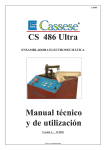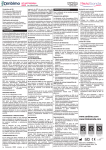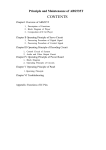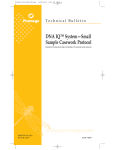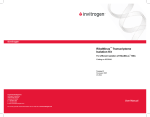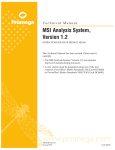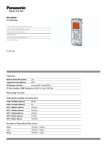Download Tips for Working with RNA and Troubleshooting
Transcript
Promega Notes Magazine Number 63, 1997, p. 17 Technically Speaking Tips for Working with RNA and Troubleshooting Downstream Applications By Mark Lepinske Promega Corporation or Working with A and Troublwnstream Applic High quality RNA is required for many molecular biology techniques. The isolation and use of purified RNA in the laboratory is complicated by the fact that, chemically and biologically, RNA is significantly more labile than DNA. The choice and optimization of RNA purification methods are important for successful isolation of quality RNA and consistent performance of downstream applications. In order to avoid damage or loss of RNA, caution should be exercised to avoid nuclease contamination of the RNA samples during preparation and handling. Q: Why is RNA so labile? RNA is extremely susceptible to degradation by endogenous and exogenous ribonucleases (RNases) that are both ubiquitous and difficult to inactivate in the presence of RNA. Care must be taken to protect RNA from all sources of RNase. Some RNases do not have the cofactor requirements that are characteristic of deoxyribonucleases (DNases). Although chelating agents (e.g., EDTA) easily protect DNA by binding divalent cations that are cofactors for DNase, they do not protect against all RNases. Q: Should I isolate total RNA or mRNA? The choice of total RNA or mRNA (i.e., poly(A) + RNA) depends largely on the downstream application for the isolated RNA. Improved sensitivity and more accurate results may be obtained using mRNA in techniques like cDNA library construction and Northern blot detection of rare messages (1). Most molecular biology applications such as RT-PCR(a) and RNase protection assays do not ordinarily require mRNA and usually work quite well with high quality total RNA. The purity and integrity of total RNA are critical whether one uses total RNA or mRNA for an experiment. Gel analysis and ribosomal band examination are effective methods for assessing the integrity of prepared total RNA samples but are not adequate measures of minor degradation, poly(A)+ tail integrity or nuclease contamination. These unknowns may be critical factors during downstream applications or further purification steps. (a)The PCR process is covered by patents issued and applicable in certain countries. Promega does not encourage or support the unauthorized or unlicensed use of the PCR process. Q: How much RNA can I expect my sample to yield? Because of the difficulty in purifying RNA and sometimes in obtaining enough RNA to quantitate accurately, one must often predict the yield and purity of RNA before the start of purification. The first concern in yield evaluation is biological: The total amount of RNA purified from a sample will vary according to the biological sample chosen and the metabolism of the cells. In addition, the quality of the sample must always be considered when assessing quantity. The handling of the tissue, the lysis of cells and the immediate inactivation of nucleases are variables that can be controlled and are necessary for effective purification and function. Table 1 provides some general guidelines for expected yields from a variety of RNA sources. Q: What are some methods for mRNA isolation? Messenger RNA is ordinarily polyadenylated at the 3´ terminus. Purification of mRNA from nonpolyadenylated transcripts is relatively simple using selective capture of poly(A) tails through binding to an immobilized oligo(dT) matrix. Methods for mRNA purification vary greatly. A few of the choices in purification techniques are batch, column or magnetics-capture technologies strategies for binding, wash and elution; use of a porous or nonporous matrix; and use of single-stage or two-stage oligo(dT) binding matrix and varied wash methods (2,3). Table 1. Yields of Total RNA and mRNA from Tissues and Cells. Total RNA mRNA *Direct Magnetic Organics-Based Extraction Method Capture from Cell/ (Promega RNAgents ® Tissue Homogenate Total RNA Isolation System) (PolyATtract® System 1000)** Tissue Mouse liver 6.6mg/g tissue 220µg/g Mouse kidney 3.1mg/g tissue 328µg/g Mouse lung 1.9mg/g tissue 100µg/g Mouse spleen 8.3mg/g cells Mouse intestine 2.3mg/g tissue Human WBC 1.3mg/108 cells HeLa cells 1.6mg/108 cells 72µg/g NA NA Mouse pancreas NA NIH 3T3 cells NA 370µg/g NA 200µg/g (~6 x 108 cells) *mRNA may be prepared directly from cells and tissues or may be prepared from total RNA. ® **The yields of mRNA using oligo(dT) are typically lower than those obtained using the PolyATtract System 1000 for the tissues listed. NA = data not available Q: How much mRNA can I expect? Traditional column techniques may appear to produce quantities of mRNA in the range of 5% of the total input RNA; however, purity is usually low with this method while actual mRNA recovery is masked by contaminating nonpolyadenylated RNA. Expected yields are usually a fraction of this amount. Large yields and high purity depend on the experience and technique of the user as well as the number of passes of the RNA over the column during binding, washing and elution. Although some methods may appear to generate high yields of RNA, mRNA capture efficiency must be considered. If the amount of mRNA isolated is low and contamination with other RNA is high, overall yield values may appear normal but are meaningless. Short hands-on time and ease-of-use are convenient attributes of a technique or commercial system for the user, and are also important for isolating quality mRNA and obtaining optimum yields. The efficiency of mRNA purification must be considered with realistic expectations of yield. Except in highly transcriptionally active cells and tissues, the typical yield of mRNA will be approximately 1-2% of total RNA. Thus, 5mg of total RNA from an average tissue will yield approximately 50µg of pure mRNA using an efficient, high purity system like the PolyATtract® mRNA Isolation System II (Cat.# Z5200). Maximal mRNA yields are obtained with the PolyATtract® System 1000 (Cat.# Z5400) for the following reasons (4): ? ? ? ? ? ? ? ? ? direct mRNA capture from a cell/tissue lysate effective cell lysis and homogenization potent and immediate RNase inactivation hydrophobic and nonporous oligo(dT) immobilization support efficient two-stage oligo(dT) annealing and immobilization rapid (~40 minute) procedure with few steps no organic extractions or alcohol precipitations no complicated or unstable reagents batch process binding, wash and elution Q: What is meant by "a low abundance RNA"? The abundance of a particular RNA is the average number of molecules of that RNA per cell. The RNA population can be divided into three general classes based upon relative abundance (Table 2). Table 2. Abundance of RNA. Abundance Category Low Intermediate High Number of Copies/Cell 515 200400 ~12,000 Number of Different Messages/Cell 11,000 500 <10 Abundance of Each Message <0.004% <0.1% 3% Q: What are some obstacles to success when isolating total RNA and how can these problems be overcome? The first step in any RNA extraction procedure is disruption of the cells or tissue. If disruption is not complete, RNA will not be released from the cells. Once the cells or tissue is disrupted, endogenous RNases are freed from the complexes and organelles that normally separate them from RNA in the cell. In order to preserve the integrity of the RNA, these free RNases must be inactivated quickly and completely as cells are broken. Cell disruption and homogenization is usually performed in the presence of a high concentration of guanidine, which denatures proteins and thus temporarily inactivates RNases. Detergents may also be used to aid in cell disruption and homogenization. The two precipitations through guanidine that are recommended in Promega's RNAgents® Total RNA Isolation System (Cat.# Z5110) are important for completely eliminating nucleases. Organic extraction alone is not adequate for most applications (5). Once cells are lysed, organic extraction with acidified phenol:chloroform:isoamyl alcohol is the most common method for purifying total RNA. The most important factors determining RNA purity during organic extraction are proper ratios of phenol:chloroform:isoamyl alcohol, adequate extraction reagents for the amount and type of tissue used and proper pH for the extraction reagents. Commercial reagents are preferred because of the difficulty in making adequately pure and consistent reagents at the exact pH necessary to partition DNA to the organic phase. Visible chromosomal DNA contamination indicates inadequate organic extraction or a reagent problem. RNA isolation techniques generally involve steps to eliminate DNA. DNA is usually removed from samples by organic extraction; it is important to minimize the amount of interface material taken during organic extraction because it can be a source of DNA contamination. When DNA must be completely eliminated from contaminated RNA samples, we recommend enzymatic means such as the RQ1 RNase-Free DNase (Cat.# M6101); this is particularly important prior to performing techniques such as RTPCR. Early in the RNA purification procedure, external sources of RNase are not a concern. However, later in purification when RNA is removed from the chemicals used to inactivate endogenous RNases, care must be taken to inactivate the RNases that are still present and to avoid introduction of exogenous nucleases. RNA that looks pure on a gel can still contain active or "activatable" RNases. Protein RNase inhibitors (e.g., RNasin® Ribonuclease Inhibitor) are often used in enzyme reactions to sequester RNases that may remain in an RNA sample or that may be introduced with other reagents or while pipetting. A number of valuable total RNA extraction precautions and troubleshooting concepts are presented in references 1, 5 and 6. Q: What are the limitations of accurately measuring small amounts of RNA? Semi-Micro or Micro Cell cuvettes must be used for sample volumes of 1ml or less. Micro Short Cells (25mm tall) can be used to measure volumes of 300-400µl, depending on the instrument. The minimum volume that can be measured in the cuvette depends upon the position of the light beam in the instrument. Refer to the owner's manual or contact the manufacturer for information. Shorter path length cuvettes can be used to measure smaller volumes, but a shorter path length requires a higher concentration of mRNA to give meaningful absorbance values. The standard path length of a cuvette is 1cm. Sub-Micro cells are available for measuring sample volumes down to 10µl. The compatibility of these cells with your spectrophotometer must be determined. For a lower signal:noise ratio, black masked cuvettes are preferable to clear wall microcuvettes. The window material of the cuvette should be polished quartz with a usable wavelength of less than 200nm (e.g., Starna Spectrosil® Far UV Quartz, Starna Cell Inc.) because polystyrene and acrylic cuvettes are not suitable for absorbance measurements between 230280nm. Readings in the range of 0.02 to 0.1 absorbance units can be unreliable (depending on the technique and instrument used), and values below this range are not meaningful. One A260 unit of single-stranded RNA is equivalent to 40µg. Thus, if accurate quantitation is necessary, we recommend use of spectrophotometric readings only for samples greater than approximately 4µg/ml RNA. Q: If RNases are not permanently denatured by autoclaving, how do I eliminate them? Glassware and other utensils used in RNA purification must be baked at 180-200°C for at least 4 hours to eliminate active nucleases. Utensils that will not withstand these temperatures must be treated with 1% hydrogen peroxide followed by a diethylpyrocarbonate(b) (DEPC)-water rinse. Gel boxes used for RNA analysis should be treated similarly. New sterile plasticware may be considered RNasefree. Solutions can be made RNase-free by treating with 0.5% DEPC overnight at room temperature in a fume hood and then autoclaving for 30 minutes; however, solutions containing Tris [Tris(hydroxymethyl)aminomethane] are not compatible with DEPC. Alternatively, commercially available products, such as RNase AWAYTM (Molecular Bioproducts), may be used for RNA work. Detergents should not be autoclaved. Gloves should be worn at all times, and proper sterile technique should be followed when handling samples and reagents. Of course, RNases may contaminate the outside of gloves after touching RNase-contaminated items like pipettes, freezer door handles, test tube racks, etc. (b)DEPC is a suspected carcinogen. Q: What RNA purification systems does Promega offer? Promega manufactures the RNAgents ® Total RNA Isolation System as well as a selection of PolyATtract® Systems for mRNA isolation. For more information on these systems please refer to Table 3. Table 3. Features of the PolyATtract® Systems. System ® PolyATtract System 1000 PolyATtract® Series 9600TM mRNA Isolation System(c) (does not include Magnetic Separation Stand) Sample Type Animal cells or tissue, plant tissues Sample Size 5mg - 1g tissue; 106 - 108 cultured cells Number of Samples per System 2 x 1g; 350 x 5mg Animal cells 2 x 102 - 1 x 288 samples or tissue 5 10 cells; 5µg (3 x 96 well - 2.5mg tissue plates) Time to Complete the Protocol Notes 30-45 minutes System compatible with all of the MagneSphere® Technology Magnetic Separation Stands. Z3790: <=3 hours Z3890: <=2.5 hours PolyATtract® Series 9600TM MultiMagnet(d) (Z3811) must be purchased separately. A centrifuge microplate carrier is required. PolyATtract® System I Total RNA 1-5mg 3 30 minutes PolyATtract® System II Total RNA 1-5mg 3 30 minutes Same reagents as PolyATtract® System I; includes Magnetic Separation Stand. PolyATtract® System III Total RNA 100-1,000µg 15 30 minutes Same reagents as PolyATtract® System IV; includes Magnetic Separation Stand. PolyATtract® System IV Total RNA 100-1,000µg 15 30 minutes (c)U.S. Pat. No. 5,552,302 has been issued to Promega Corporation for the methods and compositions for production of human recombinant placental ribonuclease inhibitor (PRI). Inhibitors of Angiogenin, which comprises a segment of human PRI, is the subject of U.S. Pat. No. 4,966,964, 5,019,556 and 5,266,687 assigned to the President and Fellows of Harvard College and exclusively licensed to Promega Corporation. (d)U.S. Pat. No. 5,567,326 has been issued to Promega Corporation for a multi-sample magnetic separation device. REFERENCES 1. 2. 3. 4. 5. 6. 7. 8. RNA Applications Guide #BR039, Promega Corporation. Farrell, R.E., Jr. (1993) RNA Methodologies: A Laboratory Guide for Isolation and Characterization, Humana Press, NY. Smith, C., Ekenberg, S. and McCormick, M. (1990) Promega Notes 25, 1. PolyATtract® System 1000 Technical Manual #TM228, Promega Corporation. Kamdar, S.J. and Evans, R. (1992) BioTechniques, 12, 632. Protocols & Applications Guide, Third Edition (1996) Promega Corporation. Berger, S.L. and Kimmel, A.R., eds. (1987) Guide To Molecular Cloning Techniques, Meth. Enzymol. 152, Academic Press. RNAgents® Total RNA Isolation System Technical Bulletin #TB087, Promega Corporation. © 1997 Promega Corporation. All Rights Reserved. PolyATtract, RNAgents and RNasin are trademarks of Promega Corporation and are registered with the U.S. Patent and Trademark Office. Spectrosil is a registered trademark of Starna Cell, Inc. RNase AWAY is a trademark of Molecular Bioproducts.





